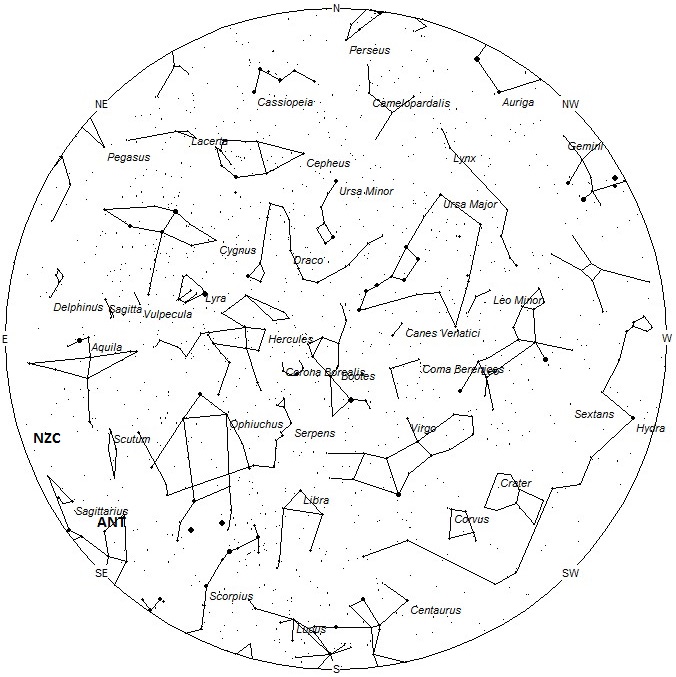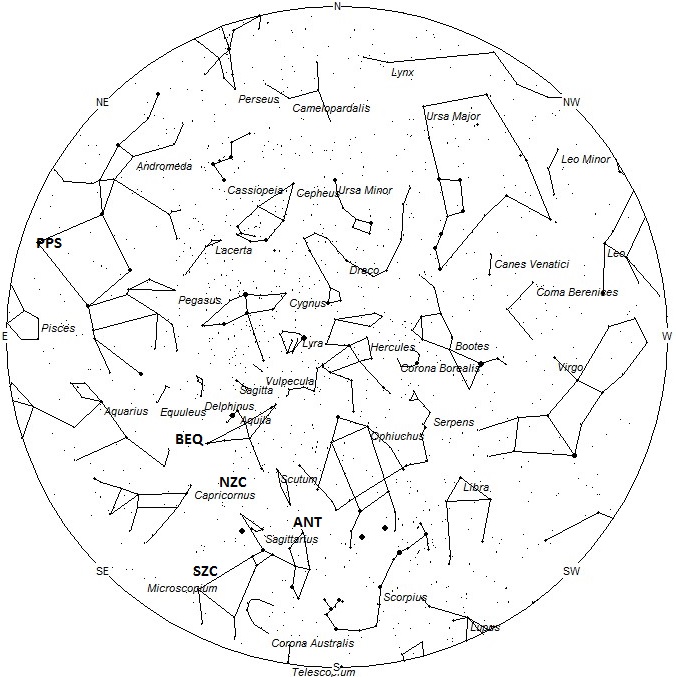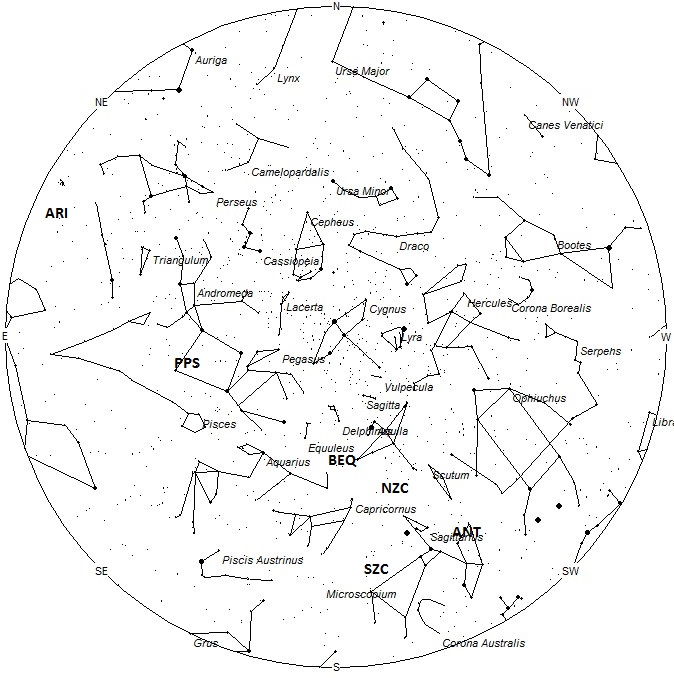
During this period the moon reaches its full phase on Monday June 17th. At this time the moon is located opposite the sun and lies above the horizon all night long. As the week progresses, the waning gibbous moon will rise later in the evening with each passing night, allowing a small window of dark skies between dusk and moon rise when dark skies are available. The estimated total hourly meteor rates for evening observers this week is near 2 for those viewing from the northern hemisphere and 3 for those located south of the equator. For morning observers the estimated total hourly rates should be near 5 as seen from mid-northern latitudes (45N) and 7 as seen from tropical southern locations (25S). The actual rates will also depend on factors such as personal light and motion perception, local weather conditions, alertness and experience in watching meteor activity. Rates are reduced by moonlight during this period. Note that the hourly rates listed below are estimates as viewed from dark sky sites away from urban light sources. Observers viewing from urban areas will see less activity as only the brightest meteors will be visible from such locations.
The radiant (the area of the sky where meteors appear to shoot from) positions and rates listed below are exact for Saturday night/Sunday morning June 15/16. These positions do not change greatly day to day so the listed coordinates may be used during this entire period. Most star atlases (available at science stores and planetariums) will provide maps with grid lines of the celestial coordinates so that you may find out exactly where these positions are located in the sky. A planisphere or computer planetarium program is also useful in showing the sky at any time of night on any date of the year. Activity from each radiant is best seen when it is positioned highest in the sky, either due north or south along the meridian, depending on your latitude. It must be remembered that meteor activity is rarely seen at the radiant position. Rather they shoot outwards from the radiant so it is best to center your field of view so that the radiant lies at the edge and not the center. Viewing there will allow you to easily trace the path of each meteor back to the radiant (if it is a shower member) or in another direction if it is a sporadic. Meteor activity is not seen from radiants that are located below the horizon. The positions below are listed in a west to east manner in order of right ascension (celestial longitude). The positions listed first are located further west therefore are accessible earlier in the night while those listed further down the list rise later in the night.
These sources of meteoric activity are expected to be active this week.
Details on each source will continue next week when viewing conditions are more favorable.
The list below offers the information from above in tabular form. Rates and positions are exact for Saturday night/Sunday morning but may be used all week long.
| SHOWER | DATE OF MAXIMUM ACTIVITY | CELESTIAL POSITION | ENTRY VELOCITY | CULMINATION | HOURLY RATE | CLASS |
| RA (RA in Deg.) DEC | Km/Sec | Local Daylight Saving Time | North-South | |||
| Anthelion (ANT) | – | 18:28 (277) -23 | 30 | 02:00 | 1 – 2 | II |
| Northern June Aquilids (NZC) | Jul 03 | 19:34 (294) -10 | 41 | 03:00 | <1 – <1 | IV |
| Southern June Aquilids (SZC) | Jul 06 | 19:53 (298) -34 | 39 | 04:00 | <1 – <1 | IV |
| beta Equulids (BEQ | Jun 15 | 20:08 (302) +00 | 33 | 04:00 | <1 – <1 | IV |
| phi Piscids (PPS) | Jul 05 | 00:00 (000) +17 | 67 | 07:00 | <1 – <1 | IV |
| Daytime Arietids (ARI) | Jun 08 | 03:24 (051) +26 | 41 | 10:00 | <1 – <1 | II |
 American Meteor Society
American Meteor Society



saw one tonight traveling I79 south at 10:10pm. spanned the whole night sky it was green N
and lasted for at least 5 seconds
very impressive
Saw on last night around 9 pm in the 270 area of Rockville, Maryland. Sorry, no photos but it was pretty and large. Thanks for the article, we are unable to find any news elsewhere regarding the sighting.
Thank you for the weekly report. It’s most helpful for those of us who find a rare night to spend under the sky .
Saw one July 18th in lutz, FL around 1145 pm. It was absolutely amazing! Blue and orange and lasted about 5 seconds!
I saw one at around 6am on Oct 5th in Brooklet Georgia while walking to my deer stand in the woods. It lit the entire woods up like daylight. I looked up to see a bright orange and white ball with a beautiful bright blue tail. It was like the biggest firework I’d ever seen. My birthday is July 4th so I’ve seen my share, but this was the most amazing thing I’ve ever seen. It took my breath away.